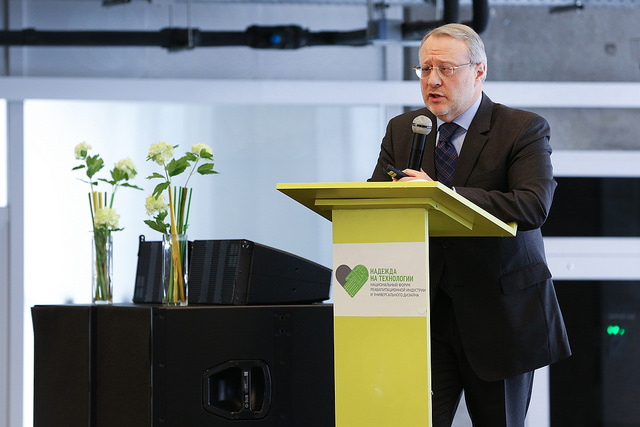Strategic Development of the Rehabilitation Industry
The Higher School of Economics designed the Development Strategy for the Rehabilitation Industry 2030, commissioned by the Russian Ministry of Industry and Trade. The strategy was presented by Leonid Gokhberg, HSE First Vice Rector and ISSEK Director, at the 1st National Rehabilitation Industry and Universal Design Forum “Relying on Technology” held on 1 December at Skolkovo.

Leonid Gokhberg, HSE First Vice Rector and ISSEK Director
Disabled people are currently seen as primary consumers of rehabilitation products, but in the future demand for assistive technologies and products is likely to significantly increase, mainly due to the growing number of the elderly and people with chronic diseases the world over.
According to HSE experts, the Russian rehabilitation industry market can double in the forthcoming decades, from 41,5 billion roubles in 2015 to 84 billion roubles in 2030. The main growth drivers are commonly linked with such trends as ageing population, persistently high occupational and household injury rates, and proliferation of certain chronic incapacitating conditions. However, development of the rehabilitation industry is affected by a more complex system of factors. E.g. in the long term the value factor may become more important (the society is likely to place a higher premium on creating equal opportunities for all social groups, and promoting an inclusive environment matching the needs of people with limited abilities), together with the infrastructure and social ones (changing lifestyles of the disabled and elderly, promoting their more active involvement in work, education, etc.).
Among the economic factors, experts highlight accelerated growth of non-public rehabilitation industry-related expenditures. Among other things this is likely to change the structure of rehabilitation products’ sales: by 2030 the share of individuals’ purchases may equal public procurement, while currently the government’s expenditures amount to 75% of the total, and individuals’ – to 25%. In turn, this shift in the sales structure will promote customisation of rehabilitation products, increase requirements to their costs and quality, and ultimately lead to a stronger competition in the industry.
Such segments as “assistive products for mobility disorders” and “assistive products for vision impairments” show the highest growth rates on the Russian rehabilitation products market (from 39,4% in 2015 to 48,3% by 2030, and from 5,8% to 11,3%, respectively).
In the long term the currently emerging technology trends will transform the rehabilitation industry, with platform technologies playing a key role (e.g. 3D printing, the internet of things, Big Data analysis, etc.). Meanwhile in several research areas (they are usually linked with diseases which define demand for assistive technologies and products) the Russian science’s positions are not yet strong enough. An evidence of that is a low (< 0,5%) share of papers by Russian scientists in the global flow of publications on such topics as spine diseases and injuries; systemic diseases; craniocerebral injuries and their consequences; chronic non-infectious diseases; learning difficulties; diseases, conditions, and injuries leading to limited mobility; degenerative joint and ligament diseases.

Elena Leontieva, Maria Kulakhmetova, Leonid Gokhberg, Ivan Biriukov
However, in other areas Russia does have top-level research results, stressed Leonid Gokhberg, giving as an example two Higher School of Economics divisions. E.g. the HSE Centre for Cognition and Decision Making designs algorithms recreating fine-motor hand movements, allowing people with writing disorders to write more clearly. The second successful example given by Mr Gokhberg was the HSE Neurolinguistics Laboratory which provides full neurolinguistics support, from diagnostics to prevention and therapy of speech disorders.
To identify and support such advanced research teams in Russia, and to more efficiently promote development and commercialisation of relevant technologies to help people with disabilities, a system for strategic planning of the rehabilitation industry’s development should be set up, including S&T policy shaping and setting relevant priorities, noted HSE First Vice Rector.
Semantic analysis of policy documents for the health, R&D, and education spheres revealed very few similarities with the documents on providing support to disabled people approved in the last five years. The only document directly influencing S&T development in the interests of this social group remains the RF Presidential decree of 27 July, 1992 N 802 “On Scientific and Information Support of Disability-Related Issues and Disabled People”.
According to Leonid Gokhberg, the key problem is inadequate arrangements for, and the status of the rehabilitation industry, in three areas – economic, institutional, and legal. Due to lack of integrated federal statistical observation in this field (measuring the output, structure, and technological level of rehabilitation products and services, and market volumes) it’s hard to assess the scope of the sector, its growth rate, and actors. This, in turn, makes regulating it and shaping an integrated economic and S&T policy to support the industry’s development even more difficult.
HSE experts suggested several first-order steps on designing a development strategy for the rehabilitation industry, including setting up an official statistics system for production of rehabilitation products; composing and approving a list of priority S&T development areas for the industry; and building relevant technology roadmaps.
Leonid Gokhberg’s presentation opened the panel discussion of the 1st National Rehabilitation Industry and Universal Design Forum “Relying on Technology” on further development of this important social area.
Text by Elena Gutaruk
Photographs by the “Opportunity Technologies” Social Innovations Development Centre
